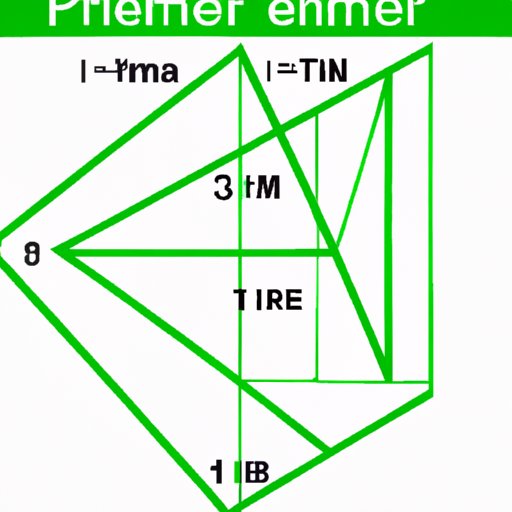I. Introduction
Triangles are one of the most fundamental shapes in geometry, and they have countless applications across various fields, from engineering and architecture to art and design. One of the essential calculations involving triangles is finding their perimeter, which is essentially the total length of the sides surrounding the figure. To help you understand how to calculate the perimeter of a triangle, this article offers a step-by-step guide, practical tips, and real-world examples.
II. Understanding the Basics: What is the Perimeter of a Triangle and How to Find It
Perimeter is the measurement of the distance around the outside of a two-dimensional figure. For triangles, the perimeter is the sum of the lengths of its three sides. Calculating the perimeter of a triangle is an important skill as it helps to measure the boundary of a given area.
Using the formula, P = a + b + c, where ‘a’, ‘b’ and ‘c’ are the lengths of the sides of the triangle, one can calculate the perimeter of any type of triangle.
III. The Step-by-Step Guide to Finding the Perimeter of a Triangle
Calculating the perimeter of a triangle requires following a few simple steps.
- Identify the lengths of the three sides of the triangle.
- Add the lengths of the sides together to determine the perimeter of the triangle.
For instance, consider a triangle with sides of length 6 cm, 8 cm, and 10 cm. The perimeter of this triangle is calculated as:
P = 6 + 8 + 10 = 24 cm
Measuring the sides of a triangle accurately is essential to get the correct perimeter. One way to do so is to use a ruler or tape measure, ensuring that the measurements are taken from end-to-end, straight along the side of the triangle.
IV. Tips and Tricks for Quickly Calculating the Perimeter of Any Triangle
Calculating a triangle’s perimeter can be simplified through a few shortcuts and tricks:
- When measuring the sides, try and work as accurately as possible to reduce errors in the final calculation.
- Remember the formula, P = a + b + c, to avoid mistakes when calculating the perimeter of a triangle.
- Use approximation to estimate the perimeter of a triangle when the sides are not specified. Approximation is particularly useful when trying to obtain quick and rough estimates of a given area.
V. Common Mistakes to Avoid When Calculating the Perimeter of a Triangle
Despite their simplicity, certain errors can occur when finding the perimeter of a triangle:
- Measuring the sides of a triangle inaccurately can significantly affect the calculation of the perimeter.
- Mixing up the formula for finding the perimeter with that of finding the area of a triangle.
One way to avoid these errors is to make sure you work through the calculation slowly and methodically, double-check your measurements, and check the formula you are using with that of the one required.
VI. Visual Aids: Using Diagrams to Help You Find the Perimeter of a Triangle
Diagrams are essential tools in geometry, especially when it comes to calculating the perimeter of a triangle.
One of the most important diagrams used in geometry is the Pythagorean theorem that represents the essential relationship between the three sides of a right triangle.
Other diagrams that may be useful in finding the perimeter of a triangle include graphs, charts, or tables.
VII. How to Apply the Perimeter Formula to Different Types of Triangles
The formula for finding the perimeter of a triangle is the same regardless of the type of triangle. However, the perimeter formula may be modified depending on the type of triangle:
- For a right triangle, the Pythagorean theorem can be applied to calculate the length of the hypotenuse.
- For an equilateral triangle, all three sides are equal, so the perimeter is merely three times the length of one side (P = 3a).
- For an isosceles triangle, two of its sides are of equal length, so the perimeter is calculated as P=2a + c, where ‘a’ is the length of the equal sides and ‘c’ is the length of the third side.
- For a scalene triangle, none of the sides has equal length; hence, the perimeter is calculated using the general formula, P = a + b + c.
VIII. Real-World Examples: Using the Perimeter of a Triangle in Practical Situations
The concept of the perimeter of a triangle can be observed in everyday life in the following scenarios:
- Construction workers use the perimeter of a triangle when making sure a foundation is square before pouring concrete.
- Designers use the concept of the perimeter of a triangle to determine the size and shape of a particular material required, such as fabrics, coverings, and labels.
- Mathematicians use the perimeter of a triangle when measuring the size of a polygon or when computing the perimeter of a large area.
IX. Conclusion
In conclusion, understanding how to find the perimeter of a triangle is a vital skill in various fields. The calculation of the perimeter gives a measure of the total length of the sides surrounding the triangle. By following the simple steps to calculate the perimeter, using visual aids, and applying the formula to different types of triangles, one can accurately calculate the perimeter of any triangle with ease. Furthermore, the practical tips and real-world examples shared in this article help demonstrate the real-life relevance of the perimeter of a triangle.

